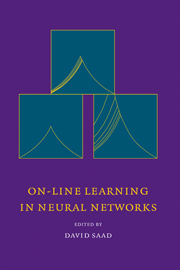Book contents
- Frontmatter
- Contents
- Acknowledgements
- List of contributors
- Foreword
- 1 Introduction
- 2 On-line Learning and Stochastic Approximations
- 3 Exact and Perturbation Solutions for the Ensemble Dynamics
- 4 A Statistical Study of On-line Learning
- 5 On-line Learning in Switching and Drifting Environments with Application to Blind Source Separation
- 6 Parameter Adaptation in Stochastic Optimization
- 7 Optimal On-line Learning in Multilayer Neural Networks
- 8 Universal Asymptotics in Committee Machines with Tree Architecture
- 9 Incorporating Curvature Information into On-line Learning
- 10 Annealed On-line Learning in Multilayer Neural Networks
- 11 On-line Learning of Prototypes and Principal Components
- 12 On-line Learning with Time-Correlated Examples
- 13 On-line Learning from Finite Training Sets
- 14 Dynamics of Supervised Learning with Restricted Training Sets
- 15 On-line Learning of a Decision Boundary with and without Queries
- 16 A Bayesian Approach to On-line Learning
- 17 Optimal Perceptron Learning: an On-line Bayesian Approach
16 - A Bayesian Approach to On-line Learning
Published online by Cambridge University Press: 28 January 2010
- Frontmatter
- Contents
- Acknowledgements
- List of contributors
- Foreword
- 1 Introduction
- 2 On-line Learning and Stochastic Approximations
- 3 Exact and Perturbation Solutions for the Ensemble Dynamics
- 4 A Statistical Study of On-line Learning
- 5 On-line Learning in Switching and Drifting Environments with Application to Blind Source Separation
- 6 Parameter Adaptation in Stochastic Optimization
- 7 Optimal On-line Learning in Multilayer Neural Networks
- 8 Universal Asymptotics in Committee Machines with Tree Architecture
- 9 Incorporating Curvature Information into On-line Learning
- 10 Annealed On-line Learning in Multilayer Neural Networks
- 11 On-line Learning of Prototypes and Principal Components
- 12 On-line Learning with Time-Correlated Examples
- 13 On-line Learning from Finite Training Sets
- 14 Dynamics of Supervised Learning with Restricted Training Sets
- 15 On-line Learning of a Decision Boundary with and without Queries
- 16 A Bayesian Approach to On-line Learning
- 17 Optimal Perceptron Learning: an On-line Bayesian Approach
Summary
Abstract
Online learning is discussed from the viewpoint of Bayesian statistical inference. By replacing the true posterior distribution with a simpler parametric distribution, one can define an online algorithm by a repetition of two steps: An update of the approximate posterior, when a new example arrives, and an optimal projection into the parametric family. Choosing this family to be Gaussian, we show that the algorithm achieves asymptotic efficiency. An application to learning in single layer neural networks is given.
Introduction
Neural networks have the ability to learn from examples. For batch learning, a set of training examples is collected and subsequently an algorithm is run on the entire training set to adjust the parameters of the network. On the other hand, for many practical problems, examples arrive sequentially and an instantaneous action is required at each time. In order to save memory and time this action should not depend on the entire set of data which have arrived sofar. This principle is realized in online algorithms, where usually only the last example is used for an update of the network's parameters. Obviously, some amount of information about the past examples is discarded in this approach. Surprisingly, recent studies showed that online algorithms can achieve a similar performance as batch algorithms, when the number of data grows large (Biehl and Riegler 1994; Barkai et al 1995; Kim and Sompolinsky 1996).
In order to understand the abilities and limitations of online algorithms, the question of optimal online learning has been raised.
- Type
- Chapter
- Information
- On-Line Learning in Neural Networks , pp. 363 - 378Publisher: Cambridge University PressPrint publication year: 1999
- 39
- Cited by

